A little mad scientist fun
If you can find it, I highly recommend The Gadgeteer's Goldmine. Laser pistol, high voltage experiments, Jacob's Ladder: This book doesn't tell you which museum you can go to see them, it freaking teaches you how to construct them.
Enough talk, this is the schematic where it shows how to construct a circuit where you can power's a car's ignition coil on a bench outside of the car.
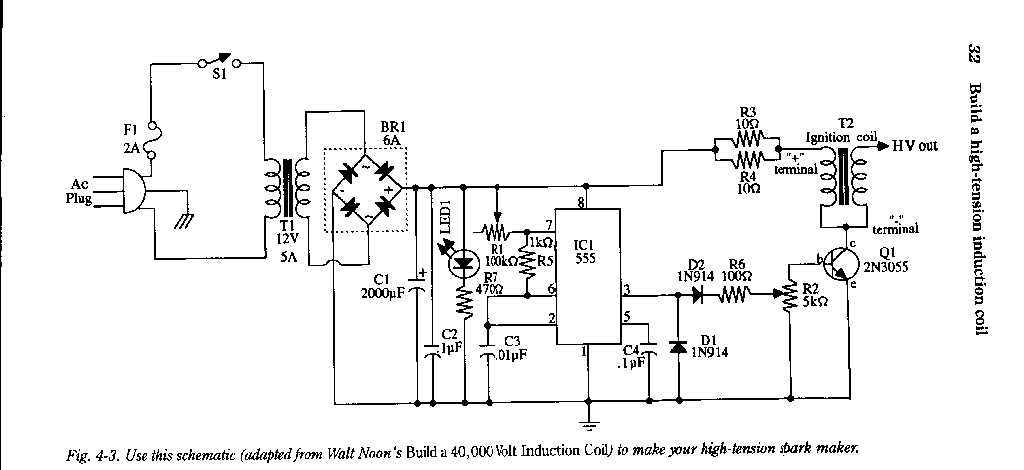
I cannot stress enough that you need to first buy the book, read its warnings, contemplate how fragile and valuable human life is, and then totally NOT BUILD THIS CIRCUIT. Don't try this at home. If you follow instructions precisely, as I did, this circuit will kill you. In a rather meaningless way as well. The only thing your cat will find is your dead corpse lying motionless on the floor with a nice barbecue smell. We can not condone the creation of hungry cats.
Current cars (read: digital age) have coil over plug, where each cylinder's own spark plug has a small coil directly over it. The advantage is so the spark power remains at 12v until inches before the plug, instead of something like 20kv some three or four feet away where it is much harder to regulate the timing digitally. An added advantage is the eliminated requirement of high tension plug wires that leaks over time and must be replaced.
But before there were more computers in cars than the moon capsule, we used to have one coil raising the voltage from 12-16v to something like 20kv, then distributors to provide the necessary disturbance to the electrical force and to direct the jolt to each cylinder's spark plug in a relatively primitive way. What all this means to us is that there is a easily available, highly dangerous part to do crazy experiments with. Auto parts store can get you a coil for about 30-40 bucks, but they always ask make and model and year before they can find anything for you. Telling them you just need a coil, any coil to zap things with is not good enough. That is why I just go to the junk yard and rip one out of an interesting looking car instead. That, and it is cheaper, greaser, lightly more bad ass than to buy your mad components new. Yeah, of course you can order one online now. While you are at it, order one of them pink Hello Kitty AK-47. Because if you are the sort of person who is mad enough to want to build a high voltage zapper to electrocute things with, but just need the parts to be shiny and neat and brand new, a cute pink kitten weapon of rapid destruction is just the thing for you. Do not come near me.
So the idea is really simple, we will make a circuit that emulates the way a normal old car would power its coil, a nice, high current pulsed supply to the coil at around 12v, then wire the output of the coil directly to whatever we wanted to zap, with it or him or her connected to ground first of course.
Simple logic tells us then when messing with this circuit the thing NOT to do would be to have yourself properly grounded. Doing so will likely end up in some unplanned barbecue. You will notice the same warning sticker on phone and power company's cherry picker trucks. Same deal with birds not getting zapped to death sitting on high voltage power lines.
Anyway, this is the thing as finished.
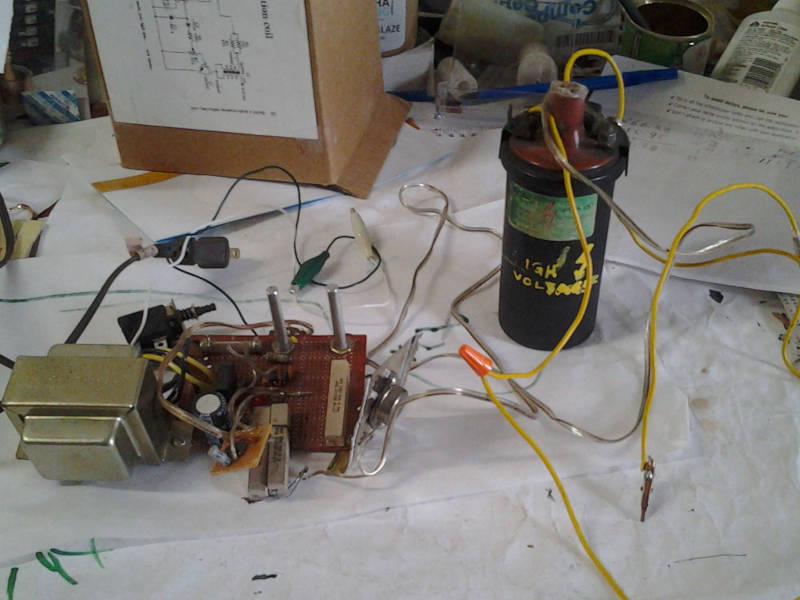
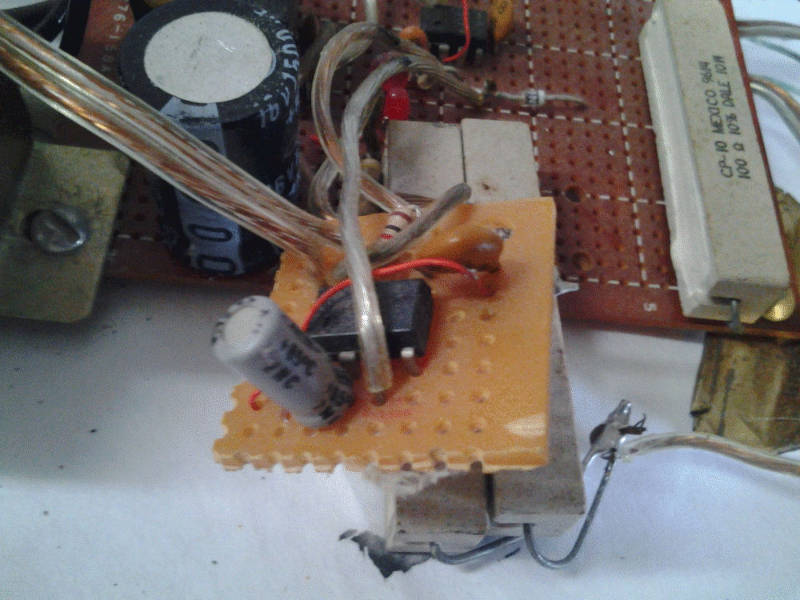
Used a breakout daughter board for a separate 555 chip running astable mode, because the 555 circuit I built on the center of the board somehow failed to generate the clock pulse, must be that disc cap between pins 1 and 2 ruining the trigger. Didn't know and didn't care because I was young when I built this. Since the other components were already in, daughter board it is. (okay, all the 555 is supposed to do is go dum-dak dum-dak, kinda like tick-tock tick-tock. A simple pulse generator. I believe the Model T used an electronic one similar to the turn signal flip flopping at a faster rate to generate its spark. It's like that fancy aero-elastic wing the supposedly advanced Tin Man has in the movie Stealth, the Wright Brothers had it on their Wright Flyer, it deformed its entire wings in a turn. Point being, sometimes the older (or original) design has elements that are more advanced than commonly accepted norms. We make our pulse generator adjustable with the two silver pole looking thing you see in the next image top right, those are potentiometers, or just adjustable resistors. Adjustable is good, because the coil output depends on strength and frequency of the input signal.)
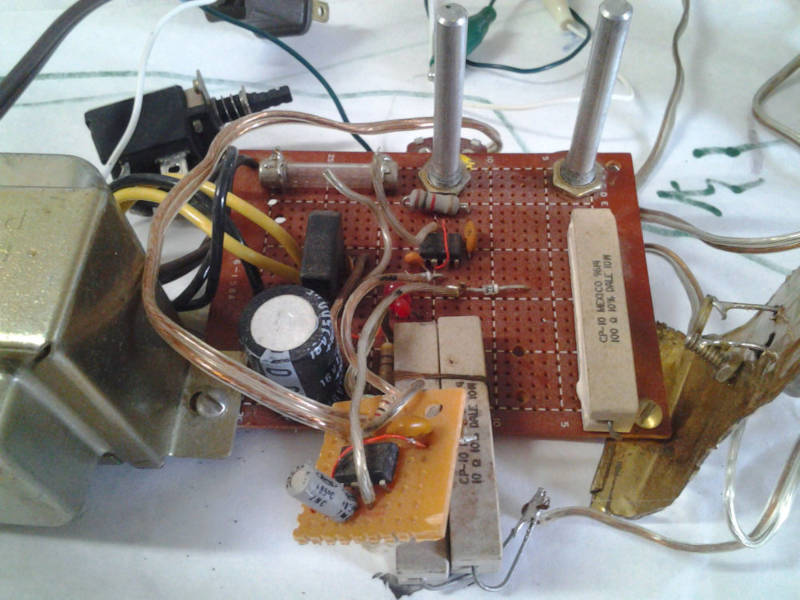
Did put in a fuse, as you can see on the top, not very mad scientist like, but hey, I already suffered a burnt out 555 chip, and that transformer from Radio Shack is expensive and heavy to mount. The last one I bought to make a regulated 12v power supply lasted forever. (see another fun book: Building Power Supplies)
Actually the fuse is there to prevent a fire after the operator has died. The problem being unwanted heat that might come with the wanted electrocution. In the event any part of the circuit is shorted out, in the absence of a voltage regulator, the low volt part will end up with too much current and heat, and a fire will result. Seeing there is no way in hell UL will ever list this thing, the least we could do is put in a 50cents fuse.
The power switch you see on top is surplus from a PC I think. Old style AT non-momentary. Using one set of the DPDT, seeing how we are making like 20kv, taking care to insulate the non-lethal 110v seems kinda pointless...
Wait, no, it is actually better to be zapped with 110v than 20kv, so this is actually a SAFETY FEATURE against getting zapped by even higher voltage.
Power cord (110vac) -> Fuse (110vac) -> Power Switch (110vac or off) -> Transformer coil (12v AC)
-> Bridge rectifier (Yellow wires, 12v DC out with ripple) -> Capacitor (to lessen the ripple)
--> 555 circuit (to make controlled pulses that triggers the base of the power transistor, low voltage low current signal)
--> to collector of power transistor (high current unpulsed 12v)->
emitter of power transistor (pulsed controlled 12v) -> coil (20kv)
-> thing you wanted zapped
The two pots on top controls strength and frequency of the control pulse signal. The coil actually has an optimal setting where the highest power is achieved, and those controls allows us to tune the output.
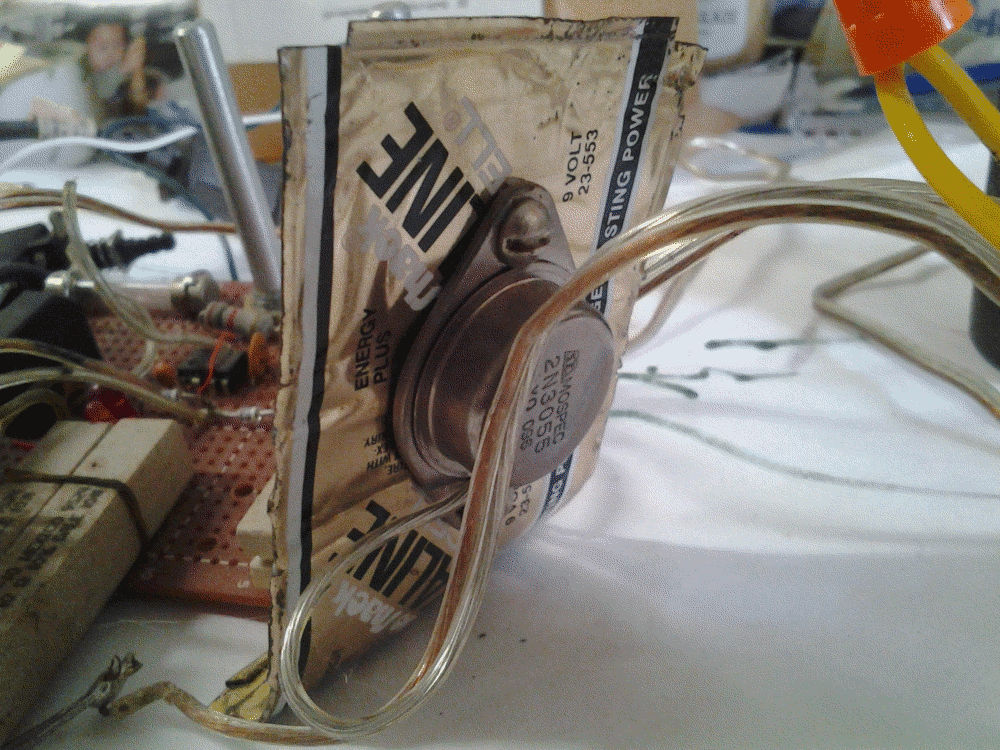
Could not find a proper heat sink for a TO-66 power transistor package. But hey, it is just a piece of metal. I have taken apart enough audio equipment to know how cheap-ass designers would do when they don't want to buy a proper heat sink, they just bolted the thing to the metal case. One could argue this dissipates heat even better than an aluminum sink stuck inside a metal case. (Then the insanity continues when they add a fan to direct airflow into the case, so some air can reach the heatsink that is inside the case! Think of the noise both from the moving air and the blade and the electrical noise! not to mention a moving part that will die eventually, taking with it the transistor when it overheats from running without a fan.) Okay, so I can't even afford a case for my rig, but the idea is the same, all I needed was a piece of metal. Remember the battery club Radio Shack used to have? One free battery per month with a membership card just so you will keep going back and spend like me, 200 bucks on the way out. Don't think I even have a dremel back then, so this was bleeding hand bent 9v battery shell with a plier and holes poked with a nail.
Those beige brick looking ceramic things are power resistors, they are used to make the current higher on its way to the 2N3055
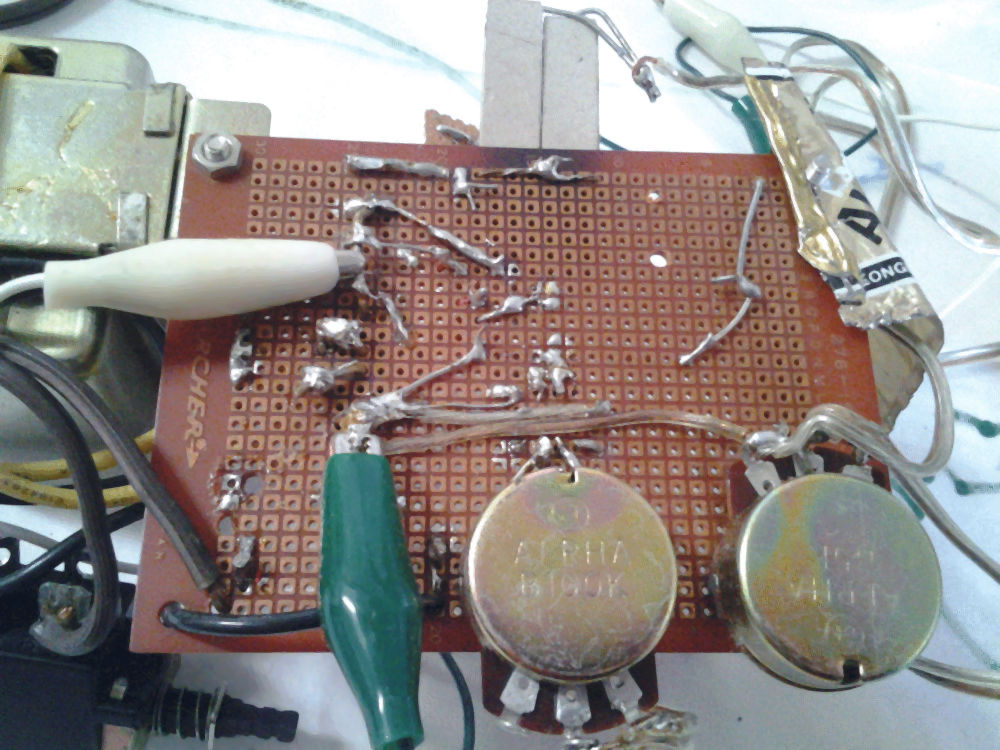
The kind of solder weld one would make with a soldering iron whilst holding back shakes caused by maniac laughing. My cousin used to work for Intel, a chip designer, one day he walked into my room, saw a grape on my table, got zapped for his sin of taking food that is not his. (He survived to design the Pentium II). After that, he once borrowed my car, and when he heard the beep beep beep of the radar detector beeping in increasing urgency, he evacuated his family from the car thinking it was a self destruct mechanism on the dash. I was laughing so hard my Koi fish leap from its tank when I got his panicked call. True story!
Also, the real self destruct was installed under the trunk, where the gas tank is. And it does not make a beep beep sound.
Article and pictures Copyright (c) 2014 Pang Industries
Schematic is taken from Gadgeteer's Goldmine, which as it says on the graphic is taken from somewhere else too.
Views: 1108
Replies coming soon